Yves GARY Hits: 4381
Category: 1885 : CHALLENGE N°5
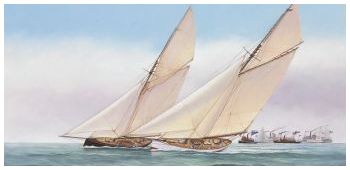 By W. P. Stephens - MotorBoating Oct. 1945
By W. P. Stephens - MotorBoating Oct. 1945GENESTA having been docked for overhauling, and before being refloated, she was measured by John M. Wilson, Measurer of the Club; who performed the same office for Puritan.
| CAMBRIA | PURITAN | |||
| Feet | Ins | Feet | Ins | |
| Length over all | 96 | 5 | 93 | |
| Length waterline | 81 | 7½ | 81 | 1½ |
| Breadth extreme | 15 | 22 | 7 | |
| Depth of hold | 13 | 6 | 8 | 5 |
| Mast, Deck to hounds | 52 | 60 | ||
| Mast, Heel to cap | 77 | 10 | 78 | |
| Mast, Diameter | 17 | 18 | ||
| Topmast, fid to sheave | 44 | 6 | 44 | |
| Bowsprit | 33 | 6 | 38 | |
| Boom, Length | 70 | 76 | ||
| Boom, Diameter | 14 | |||
| Gaff | 46 | 47 | ||
| Spinnaker boom | 64 | 62 | ||
| Topmast, Deck to block | 97 | 2½ | 102 | 1½ |
| Bowsprit to boom end | 140 | 6 | 144 | 7 |
| Displacement, Tons | 150 | 105 | ||
| Ballast total, Tons | 72 | 47 | ||
| Ballast on keel, Tons | 70 | 27 | ||
| Ballast inside, Tons | 2 | 20 | ||
| Ballast ratio to displacement | 48% | 45% | ||
| Tonnage Y.R.A. Rule | 80 | 140 | ||
| Sail area, N.Y.Y.C. rule | 7387 sq. ft. | 7982 sq. ft. | ||
| Measurement, N.Y.Y.C. rule | 83.05 | 83.85 | ||
| Allowance, 40-mile course | 31 | Allows | ||
These measurements prove the falsity of the charge made when the match was first bruited against the length and sail area rule as adopted to betray American interests; a rule which matched so evenly two yachts of radically different model but of the same waterline and sail area was certainly superior to everything which had preceded it. While New York has much to be proud of today in the great bridges which make it no longer an island, at the same time it has lost much of the picturesque in the passing of its magnificent fleet of side-wheel steamboats, with their walking beams on high and “their paddles chunking” along the Hudson, the Sound and the Bay.
These, and the great propellers which displaced them, only to disappear in turn:—the Day Line, the Hudson River Line, the Fall River Line, the Outside Line, formed a notable marine spectacle even in their daily operation, and a still greater one when with flags Flying and bands playing they followed a regatta or an international race. To be sure they found little favor with racing yachtsmen; they frequently left only a narrow lane for a yacht struggling under their lee to make the few seconds which meant success rather than defeat, and they washed all competitors most impartially, but they made regattas of what are now only races. The attendant fleet on this occasion exceeded all similar turnouts of the past.
The agreement to sail two races, and a third, if necessary, called for the first race to windward or leeward; the first attempt, on September 7, found almost a calm off the Scotland. Genesta was steered by Captain Carter and J. Beavor-Webb; as l remember, she had as local pilot Martin Lyons, an old New York pilot who had sailed some of Commodore Bennett's yachts in the past. The start was postponed until 1:35 P.M. and the race was called off at 6:50 with both yachts short of the turning mark.
There was a light breeze on September 8 and a start was called at 11:40, the course being S.S.E. Both yachts worked about under club topsails during the ten-minute interval; as it neared its end Genesta was standing for the Lightship on the port tack, while Puritan on port tack was nearer to the line but further to the eastward. Genesta came about close to the Lightship; Puritan, still on port tack, tried to force a passage between Genesta and the mark, but failed to do so. Genesta held her course, her bowsprit went through Puritan's mainsail and fetched up on the leechrope, there was a crash and the cutter paid off under Puritan's stern with her bowsprit in the water. The stick was a sturdy piece of Oregon pin, the ends showing long fractures; the copper bobstay, 1¼ inches in diameter, was bent like a fishhook, and the chainplate of the port bowsprit shroud was broken.
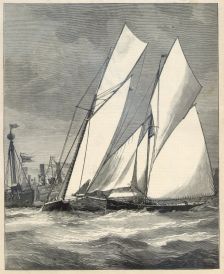 Puritan at once sailed up to the Committee boat; as she neared, one of her party, in a state of great excitement, shouted: "She fouled us. We claim the race. We will sail the course."
Puritan at once sailed up to the Committee boat; as she neared, one of her party, in a state of great excitement, shouted: "She fouled us. We claim the race. We will sail the course."
l stood almost at Tams’ elbow, he inside the pilot house and I outside, as he replied, in a calm, conversational tone: “No you won't. Not by a damned sight."
He then announced that Puritan was disqualified and she sailed away. Running over to Genesta, the first hail from one of her after-guard was the question: "How much time will be allowed to file a protest?" the present Rule 45, “Protests,” not being in the book at that time. Dr. Woodbury, representing Genesta aboard the tug, after consulting with Tams, replied:-"Three o'clock Wednesday."
The tug backed off but soon returned and Tams announced that Puritan had been disqualified, adding:
-“We will give you time to make repairs, you can rig out the spinnaker pole to make a bowsprit and if you can sail the course in seven hours we will give you the race."
On this, M. Roosevelt Schuyler, a guest aboard Genesta, put in his oar with the question:
- "How long will you give us to make repairs?"
On this Sir Richard stepped forward, almost in front of Schuyler, very quietly thanked Tams, and said that he did not come here to take a race under such conditions. 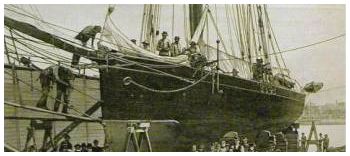 This incident was overheard by a number of newspaper men on the Committee Boat and variously reported, but I heard every word, and I believe that this version is substantially correct; there was much excitement, but both Sir Richard and Tams were cool and collected throughout. I have often regretted that Captain Collin, who was an expert in shorthand, did not take down the whole incident verbatim.
This incident was overheard by a number of newspaper men on the Committee Boat and variously reported, but I heard every word, and I believe that this version is substantially correct; there was much excitement, but both Sir Richard and Tams were cool and collected throughout. I have often regretted that Captain Collin, who was an expert in shorthand, did not take down the whole incident verbatim.
The bowsprit was parbuckled aboard the tug, with the inboard part, a line was passed to Genesta, she was dropped off her mooring at Staten Island, Captain Carter and Beavor-Webb boarded the tug and I stayed with them as they continued to Poillon's Yard. Oregon pine was as little known as teak about New York in those days; we went about the yard until a stick of yellow pine was found and men were set to work; the stick being ready by Wednesday afternoon. It weighed 2,000 pounds as compared with 1,736 pounds of the old stick. General Paine at once sent a note of apology to Sir Richard with an offer to pay for the repairs, which I believe was not accepted.
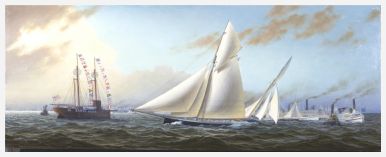 The third attempt to sail the first race was made on September 11 with a start at 11:35 in a light wind, E. x N,. with some sea offshore. After Puritan had rounded the mark with 20 miles yet to go the race was called at 5:45. After three failures to sail the first race the fourth attempt was made on September 12 under similar conditions; when no start had been made by 2 P. M. Sir Richard Sutton suggested that the race be again postponed. Later in the day, at the suggestion of the Committee, Sir Richard agreed to sail the second race on Monday and the first race on Wednesday. Puritan returned to the city late on Saturday for a final docking and scrubbing.
The third attempt to sail the first race was made on September 11 with a start at 11:35 in a light wind, E. x N,. with some sea offshore. After Puritan had rounded the mark with 20 miles yet to go the race was called at 5:45. After three failures to sail the first race the fourth attempt was made on September 12 under similar conditions; when no start had been made by 2 P. M. Sir Richard Sutton suggested that the race be again postponed. Later in the day, at the suggestion of the Committee, Sir Richard agreed to sail the second race on Monday and the first race on Wednesday. Puritan returned to the city late on Saturday for a final docking and scrubbing.
The first race was finally sailed on September 15 14. There was a light S.W. breeze on the Upper Bay, the yachts crossing together at 10:32; Puritan soon took the lead, outside the Narrows 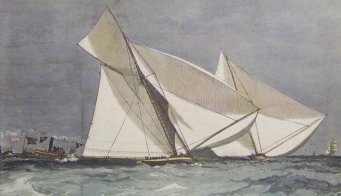 the wind fell, from the Hook to the Lightship the wind freshened from the South, Puritan leading at the turn by 4 minutes, 22 seconds. A very light West wind with a foul tide met them inside the Hook, the finish being timed at 4:38:05 for Puritan and 4:54:52 for Genesta.
the wind fell, from the Hook to the Lightship the wind freshened from the South, Puritan leading at the turn by 4 minutes, 22 seconds. A very light West wind with a foul tide met them inside the Hook, the finish being timed at 4:38:05 for Puritan and 4:54:52 for Genesta.
The second race was sailed on September 15, the course being E. S. E. 20 miles from Scotland Lightship. There was a fresh breeze at 11 A. M. from W. N. W.; Genesta led on the run, turning at 1:05:30, with Puritan 2 minutes 30 seconds astern. The wind hauled to N. W. by W. and freshened with a rising sea. The run was made under club topsails, which came down before the turn, Genesta setting a sprit topsail. As the wind freshened at 1:26 with its force as reported from Sandy Hook at 25 to 27 miles Puritan housed her topmast, Genesta sent down her sprit topsail, replacing it with a working topsail. This sail never was full, slating all the way home like her red and black private signal, the opinion of all spectators being that it hurt her badly. Puritan gradually took the lead and as the water smoothed within the last five miles she was clear ahead.
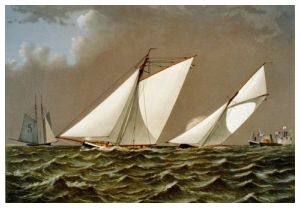 This race was the most exciting which I have ever witnessed; as Puritan neared the line Genesta luffed and gained, but dropped back; a second luff brought her close to Puritan's weather quarter, but again she fell astern only to make a third and less successful attempt as wind and sea decreased at the Lightship. Puritan crossed at 4:09:15 and Genesta at 4:10:39; the difference in corrected time being 1 minute 38 seconds.
This race was the most exciting which I have ever witnessed; as Puritan neared the line Genesta luffed and gained, but dropped back; a second luff brought her close to Puritan's weather quarter, but again she fell astern only to make a third and less successful attempt as wind and sea decreased at the Lightship. Puritan crossed at 4:09:15 and Genesta at 4:10:39; the difference in corrected time being 1 minute 38 seconds.
Sir Richard Sutton was desirous of sailing further races with Puritan, but her owners very naturally declined; Genesta entered, however, in a race for cups presented by Commodore Bennett and Vice Commodore Douglass for schooners and sloops, the course being a triangle starting from Scotland Lightship, nominally 40 miles. The starters were the schooners Dauntless, Fortuna, and Grayling and the sloops and cutters Gracie, Ileen, Athlon, Clara Isis, and Daphne. Genesta made better time by 11 minutes than the schooner Grayling and in the sloop class defeated Gracie by 21 minutes 22 seconds corrected time.
The Club had also two challenge cups Open to competition, the Brenton's Reef and the Cape May. Only the big schooner Dauntless would accept the challenge for the former, the course being from the Lightship around Brenton's Reef Lightship, about 300 miles. 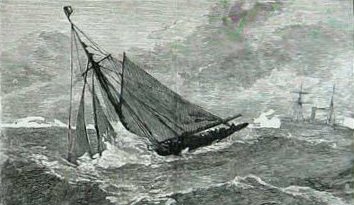 The race was sailed on September 21-2, with a start at 5 P. M. on the first date; it was sailed in a heavy gale of wind, the elapsed time of Genesta being 43 hours, 19 minutes, 40 seconds; Dauntless finishing some hours later. Both yachts lost spars and sails and had several of the crew injured. J. Fred Tams, the leading sloop partisan, sailed as Sir Richard's guest aboard Genesta. The Cape May Cup, from the Lightship around Five Fathom Bank Lightship, 216 miles, was sailed on September 26-28; again Dauntless was the only defender, losing by many hours.
The race was sailed on September 21-2, with a start at 5 P. M. on the first date; it was sailed in a heavy gale of wind, the elapsed time of Genesta being 43 hours, 19 minutes, 40 seconds; Dauntless finishing some hours later. Both yachts lost spars and sails and had several of the crew injured. J. Fred Tams, the leading sloop partisan, sailed as Sir Richard's guest aboard Genesta. The Cape May Cup, from the Lightship around Five Fathom Bank Lightship, 216 miles, was sailed on September 26-28; again Dauntless was the only defender, losing by many hours.
Genesta sailed from Staten Island on October 8, with Captain Carter in command and Captain J. W. Saunders as navigator; she had a hard passage of 19 days, 10 hours. I still have the tattered remnants of her black and red private signal sent me by Captain Carter.
 After his return to England Sir Richard Sutton was engaged to a young lady who became seriously ill; he desired to sell Genesta but as he found no purchaser he raced her, but only a few times. By this time Irex had found herself and Genesta was outclassed.
After his return to England Sir Richard Sutton was engaged to a young lady who became seriously ill; he desired to sell Genesta but as he found no purchaser he raced her, but only a few times. By this time Irex had found herself and Genesta was outclassed.
Sir Richard married and gave up racing, selling Genesta; she was later converted to a yawl and was finally broken up in 1900. Sir Richard died of peritonitis on February 25, 1891. He was a spirited yachtsman and a good sportsman; it was unfortunate that his own ill health and that of his wife shortened his racing career. Genesta was one of the finest vessels which have competed for the America's Cup, and though she was defeated she was admired by all.
Immediately after the races Puritan was offered at auction in New York in order to close the business of the syndicate. In spite of her marvelous reputation and the host of admirers, she found no bidders, and was finally bought in by Mr. Burgess, for General Paine, at $13,500. A little later she was re-sold to Vice Commodore Forbes who raced her for a couple of seasons and then converted her to a schooner. After being owned by several members of the Eastern Y. C. in succession she was sold to a dealer in old yachts and her lead keel removed. 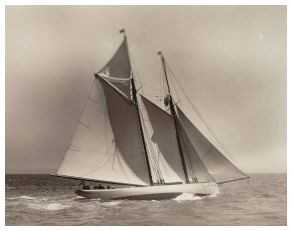 There is no further record but my recollection is that she turned up later as a packet carrying laborers between Portugal and the Azores.
There is no further record but my recollection is that she turned up later as a packet carrying laborers between Portugal and the Azores.
After laying up at her builder’s yard, Priscilla was sold in the spring of 1886 to Commodore A. Cass Canfield, Seawanhaka C. Y. C.; under Mr. Smith's direction her forefoot was cut to a depth of 15 inches, the rake of her sternpost was increased by three feet, a new and shorter mast was shipped two feet further alt, doing away with her channels, and bowsprit, boom and gaff were lengthened. Captain George Cooley was placed in command and raced through the season, she held her own with Puritan, both being astern of the new Mayflower. When Commodore Canfield designed and built the schooner Sea Fox he sold Priscilla; she was altered to a schooner and renamed Elma; later a keel was added and an engine installed, her original name being restored. Her owner, a Western yachtsman, used her for cruising down to 1917.
